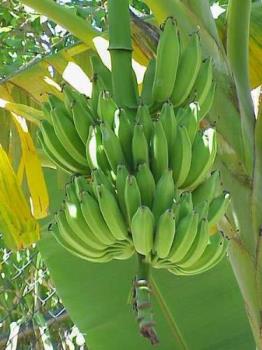BANANAS
By suneil
@suneil (109)
India
9 responses
@baileym11 (887)
• United States
2 Dec 06
Bananas are okay. I wouldn't say I love eating them.
1 person likes this
@lucaspina (372)
• Brazil
2 Dec 06
i like them but not so much for say 'love'
ehhehe
1 person likes this
@bapi_da (760)
• India
2 Dec 06
Yes I like to eat banana.Bananas come in a variety of sizes and colours; most cultivars are yellow when ripe but some are red or purple-ish. The ripe fruit is easily peeled and eaten raw or cooked. Depending upon cultivar and ripeness, the flesh can be starchy to sweet, and firm to mushy. Unripe or "green" bananas and plantains are used in cooking and are the staple starch of many tropical populations.
Most production for local sale is of green cooking bananas and plantains, as ripe dessert bananas are easily damaged while being transported to market. Even when only transported within their country of origin, ripe bananas suffer a high rate of damage and loss.
The commercial dessert cultivars most commonly eaten in temperate countries (species Musa acuminata or the hybrid Musa × paradisiaca, a cultigen) are imported in large quantities from the tropics. They are popular in part because being a non-seasonal crop they are available fresh year-round. In global commerce, by far the most important of these banana cultivars is 'Cavendish', which accounts for the vast bulk of bananas exported from the tropics. The Cavendish gained popularity in the 1950s after the previously mass produced cultivar, Gros Michel, was being destroyed by Panama disease, a fungus which attacks the roots of the banana plant.
It is common for fruit exports to be dominated by a single or very few cultivars. The most important properties making 'Cavendish' the main export banana are related to transport and shelf life rather than taste; major commercial cultivars rarely have a superior flavour compared to the less widespread cultivars. Export bananas are picked green, and then usually ripened in ripening rooms when they arrive in their country of destination. These are special rooms made air-tight and filled with ethylene gas to induce ripening. Bananas can be ordered by the retailer "ungassed", however, and may show up at the supermarket still fully green. While these bananas will ripen more slowly, the flavour will be notably richer, and the banana peel can be allowed to reach a yellow/brown speckled phase, and yet retain a firm flesh inside. Thus, shelf life is somewhat extended. The flavour and texture of bananas are affected by the temperature at which they ripen. Bananas are refrigerated to between 13.5 and 15 °C (57 and 59 °F) during transportation. At lower temperatures, the ripening of bananas permanently stalls, and the bananas will turn grey.It should be noted that Musa × paradisiaca is also the generic name for the common plantain, a coarser and starchier variant not to be confused with Musa acuminata or the Cavendish variety. Plantains have all but replaced the Cavendish in markets dominated by supply-side logistics.
In addition to the fruit, the flower of the banana plant (also known as banana blossom or banana heart) is used in Southeast Asian, Bengali and Kerala (India) cuisine, either served raw with dips or cooked in soups and curries. The tender core of the banana plant's trunk is also used, notably in Burmese, Bengali and Kerala cooking. Bananas fried with batter is a popular dessert in Malaysia, Singapore and Indonesia. Banana fritters can be served with ice-cream as well. The juice extract prepared from the tender core is used to treat kidney stones.
The leaves of the banana are large, flexible, and waterproof; they are used in many ways, including as umbrellas and to wrap food for cooking. Chinese zongzi (bamboo leaves are more commonly used where available) and Central American tamales are sometimes steamed in banana leaves, and the Hawaiian imu is often lined with them. Puerto Rican "pasteles" are boiled wrapped and tied inside the leaf.
Banana chips are a snack produced from dehydrated or fried banana or, preferably, plantain slices, which have a dark brown colour and an intense banana taste. Bananas have also been used in the making of jam. Unlike other fruits, it is difficult to extract juice from bananas because when compressed a banana simply turns to pulp.
Seeded bananas (Musa balbisiana), considered to be one of the forerunners of the common domesticated banana, are sold in markets in Indonesia.
It is reported that in Orissa, India, juice is extracted from the corm and used as a home remedy for the treatment of jaundice. In other places honey is mixed with mashed banana fruit and used for the same purpose.
@victor78 (1081)
• Malaysia
3 Dec 06
yes. sure i like eat banana. Banana is good for health especially the digest system. This is true and have been proven long time a go. Beside this, banana can make me feel more energetic as it contain high glucose content and it really taste good. In my country Malaysia, banana is very cheap and can be the cheapest fruit in the market. So, I always bought banana and eat. I can enjoy the benifits of fruit at lowest price.













